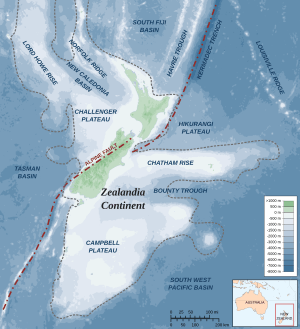Hikurangi Trench facts for kids
The Hikurangi Trench, also known as the Hikurangi Trough, is a deep underwater valley. It is located in the Pacific Ocean, just off the east coast of New Zealand's North Island. This trench stretches from the southern end of the Cook Strait to the Chatham Rise. It is like a southern extension of the much deeper Kermadec Trench.
The Hikurangi Trench is part of a special area called the Hikurangi Margin. This is a subduction zone. A subduction zone is where one of Earth's large tectonic plates slides beneath another. Here, the thick Hikurangi Plateau (which is part of the Pacific Plate) is slowly moving under the Indo-Australian Plate.
Contents
What is a Subduction Zone?
A subduction zone is a place where two of Earth's giant plates meet. One plate, usually an oceanic plate, dives underneath another plate. This process creates deep ocean trenches. It can also cause earthquakes and volcanoes.
Hikurangi Trench vs. Kermadec Trench
The Hikurangi Trench is shallower than the trenches further north. For example, the Kermadec and Tonga trenches are much deeper. In those northern trenches, oceanic crust of the Pacific Plate slides under oceanic crust of the Indo-Australian Plate. But at the Hikurangi Trench, a thicker piece of oceanic crust (the Hikurangi Plateau) goes under the continental crust of the Indo-Australian Plate. This difference affects how deep the trench gets.
Even though it's shallower, the Hikurangi Trench can still reach depths of 3,000 metres (about 9,800 feet). This deep part is surprisingly close to shore, sometimes only 80 kilometres (about 50 miles) away. The deepest point of the Hikurangi Trench is around 3,750 metres (about 12,300 feet).
Marine Life in the Trench
At the southern end of the trench, near the Marlborough region, the seafloor rises quickly. Strong winds and ocean currents in this area bring up lots of nutrients. This means many deep-water sea creatures live close to the coast.
This rich food supply attracts large animals, like whales. The town of Kaikōura is famous for its whale watching. Many different types of whales come here to feed.
Plate Movement Beyond the Trench
The boundary where these two plates meet does not stop at the trench. It continues inland. It connects to the Marlborough Fault System and then to the Alpine Fault. In these areas, the plates do not just slide under each other. Instead, they slide past each other at an angle. This creates a different kind of movement called "transpression." Transpression means the plates are both sliding past each other and pushing together.
See also
 In Spanish: Fosa de Hikurangi para niños
In Spanish: Fosa de Hikurangi para niños


